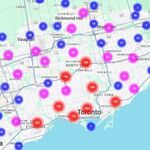Redroom Studios
Senior Member
Anyone from Niagara would tell you they have nothing to do with the GTA. People in Niagara barely (more like rarely) associate with Hamilton never mind Toronto.
i'm from Niagara and I would disagree with that. Whenever I am travelling internationally and am asked where I am from I may say either Niagara Falls or Toronto and invariably when asked to describe my part of the world I end up refering to the (Greater) Golden Horseshoe and its population of ~ 8 million.
I spend 95% + of my time in various locations throughout the GGH ... this is what defines "my world", all centered around Toronto.




